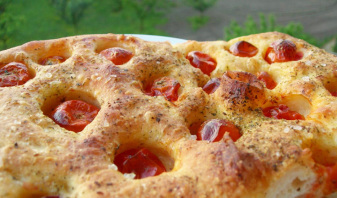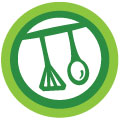
Pillowy focaccia with cherry tomatoes
By Tristan Plowman
I’d never heard of Le Marche before but a love of Italian food coupled with the reputation of
Cambridge Cookery School was enough to convince me to spend a week there devoted to its cuisine and culture.
Upon arrival our welcome by hosts Tine and Liz was a sign of things to come. They greeted us with a “light” lunch served with local white wine. Then later cooked us dinner and introduced us to the Italian aperitif, Aperol Spritz. The whole first day we were pampered and apronless from start to finish.
The next day cooking would begin in earnest fuelled by Liz’s “legendary” granola. Most of the action takes place in the main kitchen, which is very well equipped and surrounds an island work station that makes gathering around and mucking-in very convenient. Patio doors can be opened to keep the whole space nice and airy. Essential when you factor in the heat of the kitchen and some vigorous cranking of the pasta-roller.
Cooking was always a united effort, executed in small groups each tackling different dishes and/or techniques. There was plenty to do, sometimes working against the clock to get our evening meal prepped before heading out for the day was a thrilling challenge.
We were given full recipe sheets and a lot of autonomy, but Tine and Liz were always on hand to provide practical assistance and expert guidance.
There were too many cooking highlights of the week to list them all but here is a flavour of some.
Sgombri arrosto: essentially a mackerel sandwich stuffed with seasoned breadcrumbs, baked then served with a sensational salsa verde. Fish prep always reels in some top tips, and this was no exception. We were told not to gut the fish before filleting, as a firmer structure makes the job easier and the fillets neater.
When preparing Calamari, instructions were to score the squid with the knife at a very sheer angle to ensure only the membrane is penetrated and not the entire flesh.
Classic focaccia: we learnt that half the liquid used should be water, which creates more steam. The result is soft and pillowy; a delicate loaf perfect for mopping up tomato-heavy ragu.
Tine showed us how to make our own sourdough starter and the straightforward advice was to allow it 72 solitary hours to “grow” after which time periodic “feeding” with flour and water nurtures it into provable dough.
Another thing to remember when mixing dough is that “wetter is better”. It is easier to add more flour to wet dough than adding liquid to a dry mixture.
Traditional Italian desserts included a hand-made meringue based lemon ice, the ever-reliable tiramisu and a soothing vanilla panna cotta. Our last supper was an outstanding saltimbocca – veal wrapped in Parma ham, fried in butter, sage and simmered in Marsala wine. Another highlight was vincigrassi, or “lasagne for a prince”, a classic dish from Romagna that uses cured ham and mushrooms instead of mince.
Above all else, fresh pasta was the most fun to prepare. The team effort required became a satisfying social event, conjuring images of typical Italian matriarchs sitting down to hand-roll pasta. Initially, the process is rather fiddly but once you get the knack it becomes addictive, much like the delicious results. In this case, tortellini in pork broth, ricotta-filled ravioli, classic spaghetti alle vongole and chestnut flour pasta under a blanket of sage butter were salient reminders of why Italian food at its simplest wins out every time.
Once again, Tine demystified pasta-making and provided just a few basic principles. We learned to start the roller width at setting 6, fold and roll the sheet of pasta through five times, then follow this with two repeat rolls from settings 5 down to 2. The sheet becomes longer and more transparent and is ready when “thin enough to read a love letter through”.
For pasta dough, Tipo “00” flour is the ideal option due to its finer texture, which creates silky soft pasta. In lieu of this Tine suggests using half regular flour and half semolina. In any case, she recommends adding semolina to pasta dough as it lends a richer colour and greater depth.
On trips out to the Sibillini mountains and the farmers’ market at nearby Cingoli, Tine encouraged us to look around, chat to the traders and “choose anything you want to try and we’ll cook it” – a spontaneous approach that constantly kept things exciting.
A truly inspired experience was the afternoon spent in the decadent grounds of Michelin-star restaurant L’Enoteca, where chef patron Michele granted us exclusive access to his vegetable garden, allotments and wild hedgerows, providing a sneak preview of the inspiration behind his award-winning cuisine. We nibbled on wild garlic, wild celery, carrot flowers, lemon balm, baby apples and hawberries as Michele riffed passionately on nature’s bounty. By the time we sat down to a five-course lunch, our senses were tingling and tastebuds primed.
We all left Le Marche feeling confident and inspired, each vowing to recreate as much as possible from our trip to impress friends and family. Back in London, I made it my priority to track down some Tipo “00” flour, whereupon I proceeded to my brother’s house and demanded he retrieve the pasta machine from the attic.
In a nutshell:
Transport: The gateway to Le Marche is Ancona with flights direct from Stansted. It’s a 45-minute drive from the airport to Villa il Boschetto in the foothills of the Sibillini mountains.
Accommodation:
Villa il Boschetto is named after the scented pine trees encircling it, is a beautifully rustic conversion of former cow sheds, and the proud owner a close friend of the school. A central feature of the spacious house is the open staircase, which connects the stone-floor lounge area to a second floor mezzanine. Here you will find most of the five bedrooms, which boast huge bathrooms, attractive wrought iron king-size beds and charming wooden beams. A shaded terrace outside the villa leads onto the wide-open garden where the salt-water swimming pool and open air kitchen sit side-by-side. The latter is a typical Italian feature so it was gratifyingly the go-to for a lot of cooking and dining.
Tuition: The teaching was truly inspirational, and I returned to my home kitchen with a renewed vigour. Our trip was expertly orchestrated but never felt regimented or restrictive and there is so much packed into the week, it’s impossible to feel short-changed.
Holidays in 2015:
Cambridge Cookery School’s third Cooking in Italy trip takes place 5-11th June at Villa il Boschetto. Prices range from £2,000 to £2,700 per person excluding flights.
In addition, a Secret Italy Slow Food Trail runs 8-11th May, and an Italian Truffle Trip 30th Oct- 2nd Nov, both in Le Marche. Another autumn trip will see Tine take guests on a journey back to her roots with a Stockholm Heritage Food Trip (2-5th Oct).
See website for more details or email trips@cambridgecookeryschool.com
